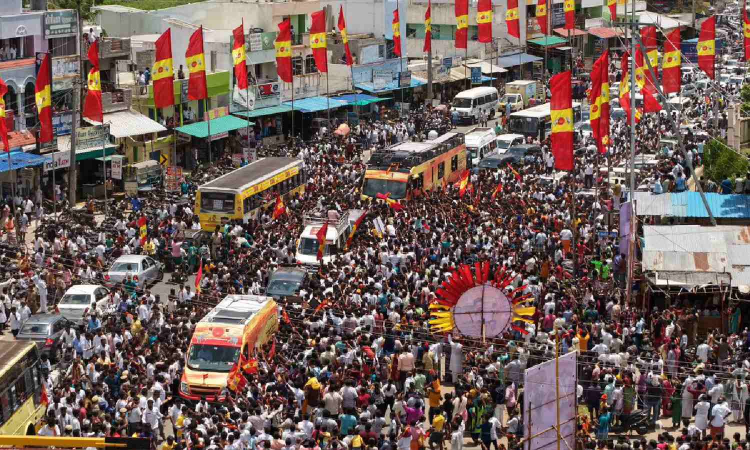Wake up before a crowd gathers
The most worrisome aspect of any of these stampedes is that glaring lessons available from the preceding events were not learnt.

Even for a shoving, jostling country like India, the series of stampedes witnessed at disparate locations in the past one year is remarkable. Tragedies arising from poor crowd management have occurred at Goa, Hathras, Prayagraj, Tirupati, New Delhi, Hyderabad and Bengaluru, taking an aggregate toll of at least 200 lives. The stampede at the Tamilaga Vettri Kazhagam (TVK) rally at Karur on Saturday night, Sept 27, is only the latest in this macabre sequence.
The most worrisome aspect of any of these stampedes is that glaring lessons available from the preceding events were not learnt. Even a cursory glance at the history of stampedes in India indicates that events relating to religion, films, cricket and politics are the most susceptible to adverse crowd outcomes. Nothing attracts a crowd like these four sectors. No other kind of event demands more alacrity. Yet, it cannot be said that India’s public authorities are extra alert to the trouble lurking at such events. At best, their main method of management is to deploy manpower. Often, that’s not an adequate response. In fact, it’s an antiquated one. In the Karur case, deploying more policemen to an already packed venue might not have helped as much as working in concert with better-informed event organisers would have.
Better-prepared authorities and organisers would know that, in a surcharged atmosphere, a baton charge or an unforeseen event could potentially trigger a stampede. We saw that happen in the melee for laddu tokens at Tirupati back in January. In both the stampedes at the Chinnaswami stadium in Bengaluru in June and at a film star event in Hyderabad last December, it was precipitate action by bouncers at a crowded gate that set off the crush. All too often, organisers employ bouncers who are trained to protect the main attraction but ill-equipped to defuse a developing situation.
The recurrence of stampedes in India, and the common patterns evident in them, calls for the adoption of a nationwide crowd control protocol for both event organisers and public authorities. Although the National Disaster Management Authority published a crowd management manual more than 11 years ago, with specific recommendations for local authorities, few authorities have implemented them seriously.
Foremost among the NDMA’s recommendations is for authorities and organisers to carry out capacity estimation and crowd profiling ahead of an event. It is not enough to assume, as was apparently done for the Karur event, that a venue is fit for a political rally because previous rallies there passed without incident. Each rally and each speaker brings along a different chemistry. Similarly, it is not good enough to rely on the organisers’ estimate of the expected crowd size. The TVK rally organisers apparently anticipated a crowd of 10,000 but three times that many turned up. Such an underestimate happened in the Bengaluru stampede as well, as often happens when film or sports stars are the attraction. Quite possibly, when permission was applied for, the crowd estimate was left to a peremptory party minion not conversant with the bad possibilities of misleading the authorities.
But the most important lesson from Karur and its preceding tragedies is the need to move from a crowd control approach to a prevention plus management approach involving multiple stakeholders—including local residents. There is technology available for it and a lot of data offering important learnings. We must give it the seriousness it deserves.



